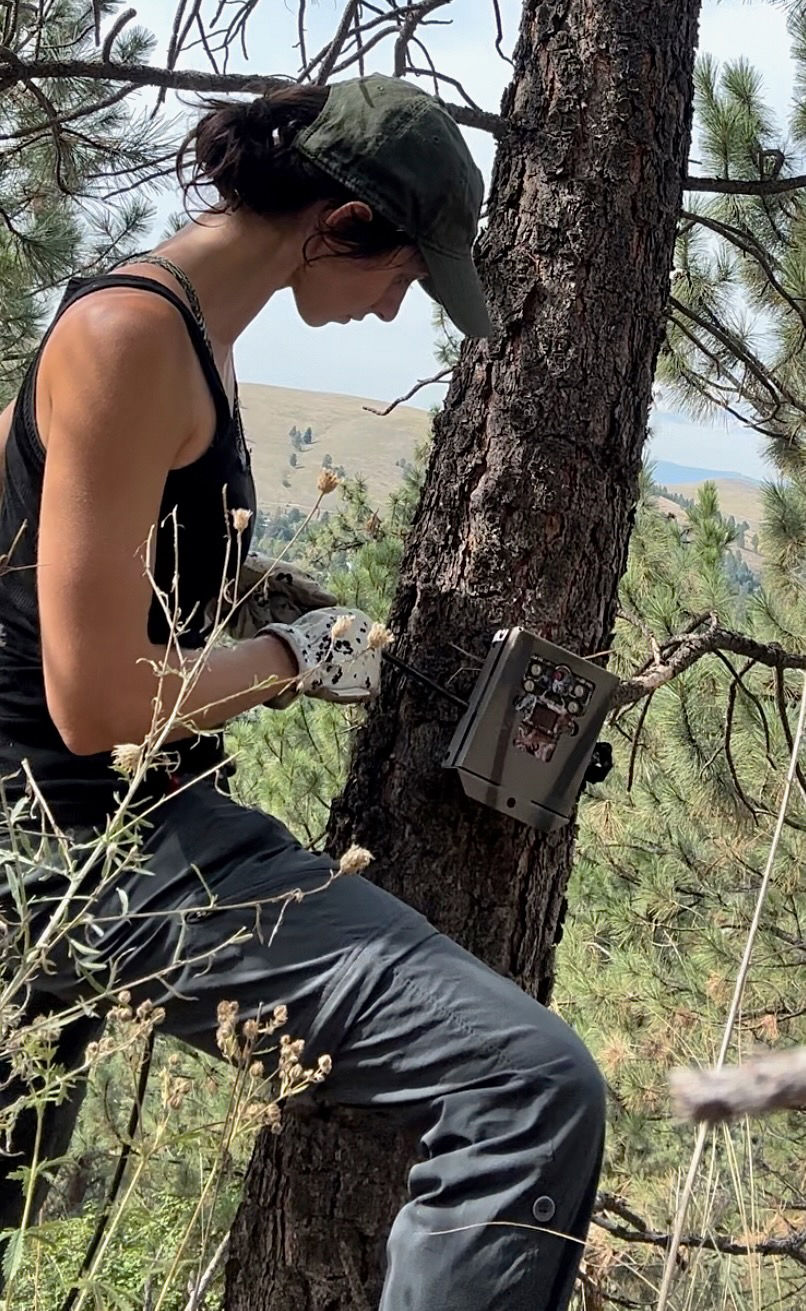By Emily Senkosky, UM News Service
MISSOULA – University of Montana student Jay Schutze has discovered that, here in Missoula, the cat is out of the bag.
Last fall, when Schutze went for a drive with their partner to look at the changing foliage by Butler Creek, they saw a herd of what looked to be 30 cats coming over the hill. Although Schutze was aware of cat colonies in Missoula since 2022, this was the first time they had seen one. Upon more research, Schutze found a growing trend of cat colonies in the area.
Now they are conducting groundbreaking research on the growing phenomenon and the impacts of feral cats on biodiversity in Missoula.
Schutze, a UM wildlife biology and nontraditional undergraduate student in the W.A. Frank College of Forestry and Conservation, has had a love for animals that began at age 14 while working as a horse ranch hand. This interest only grew and diversified in adulthood when they worked as a veterinary technician and later a dog trainer.
Schutze also is fascinated by wildlife, which led to wildlife rehabilitation and sanctuary work in everything from syringe-feeding orphaned fox squirrels to conducting behavioral enrichment with captive wolves.
When Schutze entered the wildlife biology program at UM, their collective experience in ethology – the study of animal behavior – was brought together when they discovered a peculiarity in Missoula’s city code regarding domestic cats.
According to Schutze, the Missoula city ordinance somewhat sanctions the existence of domestic cat colonies, stating that a cat can wander freely outside if neutered and spayed. At the same time, there is no local entity in the city that can regulate populations, because once a cat is feral, they cannot be adopted. This has led to an uptick in feral cats across local urban and wildlife areas and an increasing number of strays banding together.
“Cats pretty much have free roam of the city,” said Schutze.
In a phone call to AniMeals, a no-kill adoption center and nonprofit animal foodbank, Schutze learned that more than 50 cat colonies are projected to live in Missoula, with an average of 25 cats per colony. They often can be found settled with unhoused people, with a colony of 66 cats discovered in 2022 when police broke up an encampment by the Reserve Street bridge.
Although it is well known that cats have significantly impacted the populations of native bird populations, there is a growing body of research that indicates they adversely impact a wide variety of other species. The American Bird Conservancy contends cats have contributed to the extinction of 63 species of birds, mammals and reptiles in the wild. This phenomenon of another species roaming around in the wild could change the behavior of wildlife species within city limits and the wildlife landscape.
“Cats can create what is known as a ‘landscape of fear,’” said Schutze. “A cat’s mere presence in an animal’s habitat could be enough for a mammal to avoid an area, a bird to abandon their nest or even attract other potential predators to the area.”
Schutze’s research will expand on the work of Christopher Hansen, a postdoctoral research associate in the UM Boone and Crockett Wildlife Conservation Program. Hansen recently had his study on the effects of urbanization on wildlife populations published in the Journal of Mammalogy. Narrowing the focus of Hansen’s findings, Schutze will look specifically at how domestic cats interact with other wildlife in the same geographic scope across urban and wild areas. They will use 100 motion-activated trail cameras to monitor domestic cats and wildlife to see how their presence might change other species’ behaviors.
According to Schutze, they also will integrate Hansen’s data on human-wildlife crossover and conflict into the model, hoping to gather data on where domestic cats are, what other species are sharing space with them and how this is impacting wildlife behavior. The ultimate goal of the research is determining how biodiversity in the Missoula area is impacted by domestic cats.
“As urbanization continues to increase in the American West, it is increasingly important to identify potential environmental impacts of development to facilitate sustainable land use,” said Hansen, who also advises on Schutze’s project. “We hope Jay’s work will help shed light on the complex relationship between domestic and wild species and how that relates to biodiversity around the places we live.”
Schutze’s field study will be in collaboration with UM’s Avian Science Center and the Boone & Crockett Wildlife Conservation Program and also will encompass their senior thesis and Davidson Honors College capstone project. Schutze hopes to continue their fieldwork to help evolve wildlife policy to be more informed on the nuances of human-wildlife interactions.



